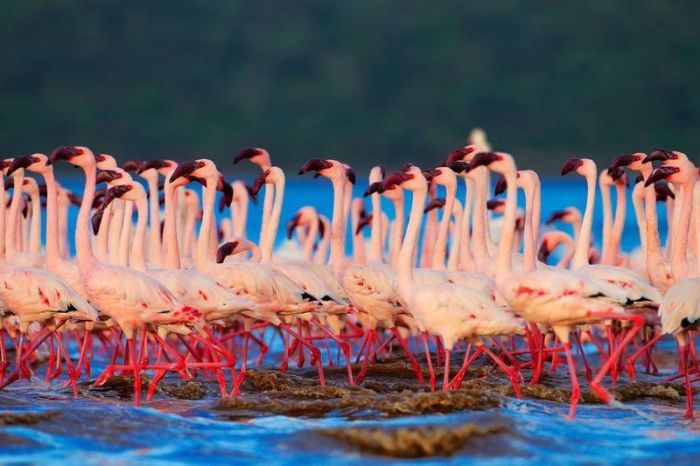|
|
Pink Blanket Of Flamingos, Rift Valley Lakes, Nakuru Lake National Park, Kenya
|
Flamingos are very social birds that live in colonies that can number in the thousands. These large colonies are believed to serve three purposes for the flamingos; predator avoidance, maximizing food intake and exploiting scarce suitable nesting sites. The most basic and stable social unit of flamingos are pair bonds which are made up of one male and one female. The bond between them tends to be strong, however in larger colonies, where there are more mates to choose from, mate changes will occur. In pair bonds, both the male and the female contribute to building the nest for their egg and defending it. Before breeding, flamingo colonies split into breeding groups of around 15-50 birds. Both males and females in these groups perform synchronized ritual displays. These displays serve to both stimulate synchronous nesting and establish pair formation for birds that do not already have mates. A flamingo group stands together and display to each other by rasing neck, followed by calling with head-flagging and then wing flapping. The displays do not seem to be directed towards an individual but instead occur randomly.
Flamingo pair bonds establish and defend nesting territories. They locate a suitable spot on the mudflat to build a nest, which is usually chosen by the female. It is during nest building that copulation usually occurs. Nest building can also be interrupted by another couple trying to steal the nesting site. Flamingos will viciously defend their nesting sites and young. After the chicks hatch, the only parental expense is feeding. Flamingos produce a crop milk, like pigeons and doves, due to the action of a hormone called prolactin (Columbidae). It contains more fat and less protein than the latter does, and it is produced in glands lining the whole of the upper digestive tract, not just the crop. Both parents nurse their chick, and young flamingos feed on this milk, which also contains red and white blood cells. In the first six days, the adults and chicks stay in the nesting sites. At around seven to twelve days the chicks begin to move and explore their surroundings. After two weeks, the chicks join groups called "microcrèches" and their parent soon leave them in these groups. Later, many microcrèches come together to form crèches which contain thousands of chicks. Chicks that do not stay in their crèches are vulnerable to predators.
|
|









